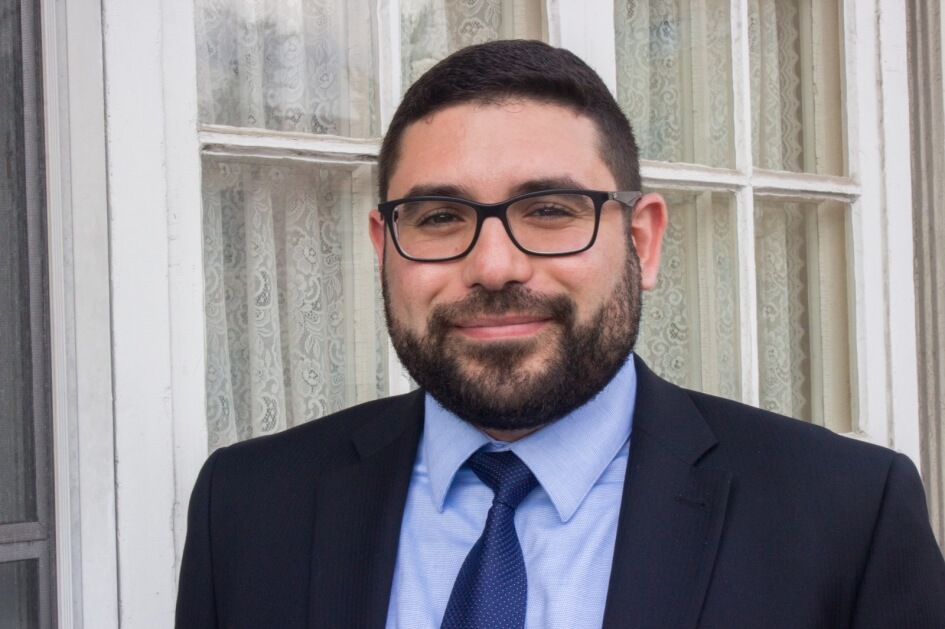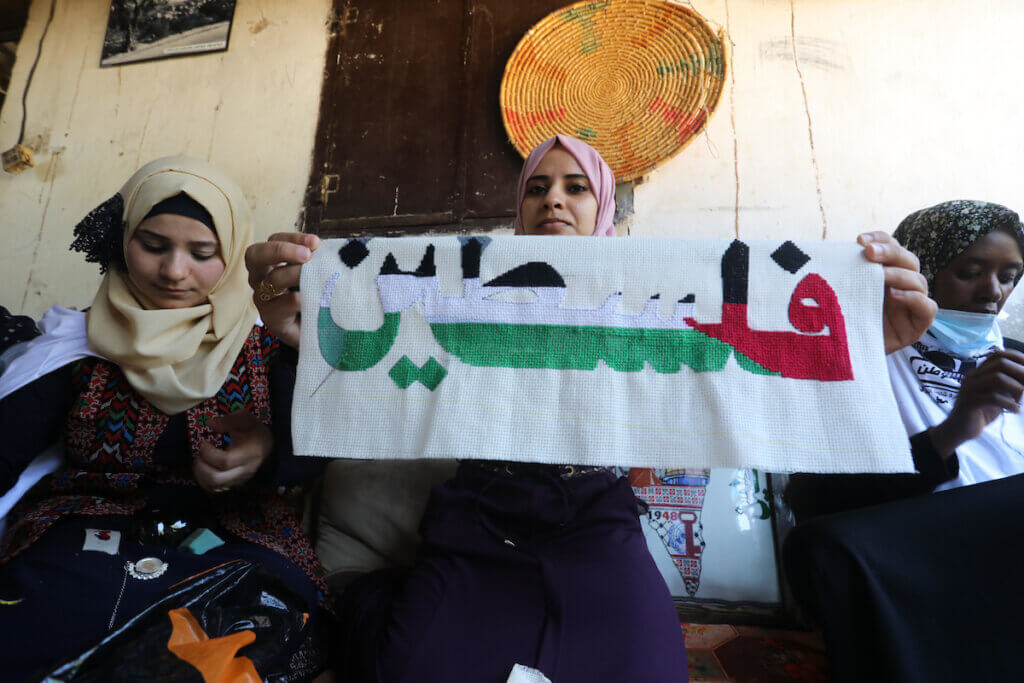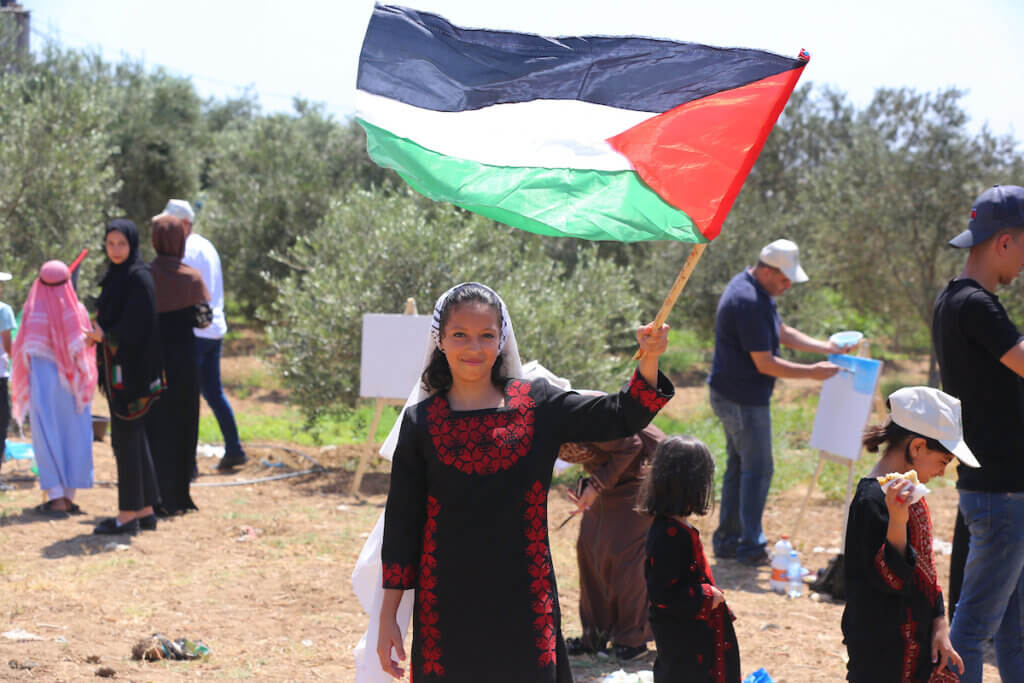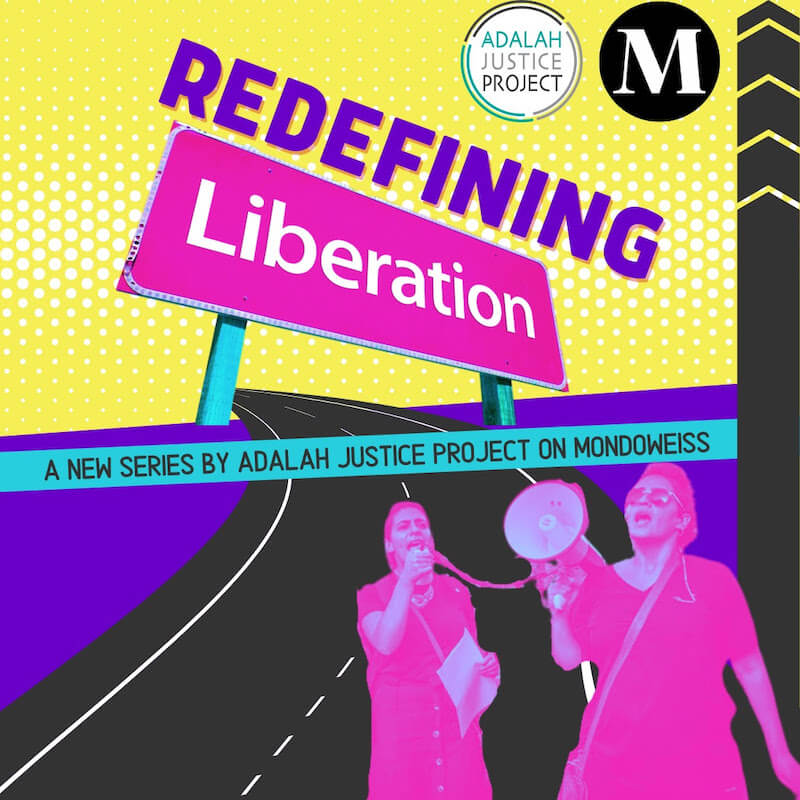Adalah Justice Project’s Sumaya Awad talks with Jehad Abusalim about Gaza, the Palestinian Authority, and the US movement for Palestine in the wake of the latest Israeli aggression on Gaza. Jehad is a PhD candidate at the History and Hebrew and Judaic Studies joint program at New York University where he studies Arab intellectual writings on Zionism from the first half of the twentieth century. Jehad is also the Education and Policy Associate of the Palestine Activism Program at the American Friends Service Committee.
AJP: Gaza is often left out of the conversation, not just among governmental bodies, but even within the NGO and grassroots sphere. The attention on Gaza shifts away when the bombs stop falling. What does it mean to talk about and organize for Gaza beyond Israel’s bombing sprees?
JA: In Gaza, the violence that Israel exercises and the kind of tools it uses to punish Palestinians and brutalize them differ compared to other parts of Palestine. But, of course, it’s essential to recognize that even though these tools vary in scale and intensity, they work to achieve the same goals: erasing Palestinians and preventing them from attaining self-determination and returning to their homes and lands.
Because the violence against Gaza is unique in the sense that Israel takes it to brutal and extreme levels, people in the movement in the US, and the global solidarity movement in general, feel a sense of relief once the bombs stop falling. While it is necessary and understandable to feel this sense of relief – even Palestinians in Gaza feel this relief – that doesn’t mean that violence against Palestinians in Gaza stops when the bombs stop falling.

We tend to focus on spectacular violence, scenes of explosions and bombs. There is no question that moments of large-scale bombardment of Gaza— large-scale killing, destruction of entire neighborhoods and residential and commercial buildings—must invite large-scale responses by the movement. The flip side, though, is that once the bombs stop falling, we tend to feel relieved, which results in losing momentum – which is objectively hard to maintain- especially when it comes to powerful – but temporary – manifestations of solidarity such as large protests, celebrities speaking out, etc.
Another problem results from Palestinian fragmentation. There is a negative role that the Palestinian Authority and its proxies play to undermine conversations around Gaza, especially when it comes to efforts to end the isolation and blockade of the Gaza Strip. This is often subtle but sometimes explicit. They encourage Palestinians and advocates to constantly be cautious when talking about Gaza because God-forbid, according to their logic, talking about Gaza represents a threat to “national unity.”
For the Palestinian ruling class in the PA and their business class allies, establishing a state on ‘67 lines is just a slogan behind which they hide, even though they know it will never happen. But without the illusion of such a slogan, they will lose their raison d’etre. For them, the priority is continuation of the status quo, which allows the PA to rule, control, and take over vital national institutions (such as the PLO) and monopolize the formal representation of the Palestinian people.
There has been an improvement in how the movement in the U.S deals with Gaza. They invite speakers, organize events. They try to connect on a personal level with organizers in Gaza. More can be done, especially around the issues of freedom of movement and our rights as Palestinians, to visit and to see Gaza. We must reject the ceiling that Israel creates about what can and cannot be talked about when it comes to Gaza.
When Israel carpet bombs the Gaza Strip and kills 300 people in 11 days, destroys thousands of residential and commercial properties, that shouldn’t mean that we can’t talk about the blockade, the prevention of Palestinian refugees from returning to their homes, the fact that Palestinians in Gaza have six hours of electricity, that students can’t travel freely, the fact that we can’t visit our families in Gaza. We can’t give Gaza only seasonal attention. The violence continues. Ending the political isolation of Gaza and trying to make Gaza a place we can imagine living in is our mandate.
AJP: You mention the role of the PA in clamping down on attempts to organize internally among Palestinians against the blockade and against the isolation of Palestinians in Gaza. Why is talking about the PA particularly important when it comes to Gaza and not just the West Bank?
JA: The PA’s legitimacy to rule, to use violence against Palestinians, to negotiate on their behalf, and to dominate national institutions, doesn’t stem from a contract with the Palestinian people, through transparent democratic processes. Instead, the PA relies on the outside; it rules and uses violence because the international community enables it to do so. The PA sidelines political parties, factions, large segments of Palestinian civil society, intellectuals, and so on from accessing formal politics. The exclusion of Gaza is a crucial part of this process. Hence, the PA elite perceives attempts to end Gaza’s isolation as a threat to their interests.
In this context, the PA conditions any improvement in Gaza’s conditions (including ending PA sanctions and policies against Gaza) on achieving national unity, a vague term that refers to impossible arrangements between the various Palestinian factions, mainly Hamas and Fateh. The PA has promoted a narrative over the past few years that issues like the blockade on Gaza, opening Gaza to the world, resolving Gaza’s economic situation, and reconstruction following Israeli agressions, and so on must happen only through channels that involve the PA itself.
The PA paints any organizing inside or outside Gaza as attempts by the international community to divert attention away from the Palestinian “national consensus.” So we end up with a narrative that makes activists super cautious when talking about Gaza in ways you don’t see when we talk about Sheikh Jarrah, settlements in the West Bank, or the rights of Palestinian citizens of Israel. Why? Because the PA knows that Gaza holds so much political and symbolic power, and the narrative the PA promotes is not rooted in anything positive the PA does, but instead in the PA distancing itself from Gaza and factions there.
This discourse makes civil society in Gaza tone down appeals to end the blockade and to end Gaza’s isolation because they feel that if they do so, they are undermining Palestinian “national consensus.” As a result, they become victims of the inability of the Palestinian body politic to achieve any consensus or popular mandate. In short, the PA markets itself by telling the international community, “We are not Gaza, therefore support us.”
The PA is complicit in sanctioning and collectively punishing Palestinians in Gaza. Palestinians in the US shouldn’t be hesitant to call out Palestinian officials with past or present ties with the PLO when they come to our activist spaces. We must ask them where they were when Mahmoud Abbas issued decrees to cut electric fuel supplies rendering electricity to 4 hours a day in 2017-2018. Or when Abbas cut the salaries of public servants in the Gaza Strip. We shouldn’t hesitate to call out the PA and its allies when they use a narrative that demonizes Gaza that allows them to maintain their contacts and ties with the international community.
I was invited to a private gathering between a member of the so-called Palestinian National Council and American Jewish community leaders a couple of years ago. In the meeting, which happened during the Trump administration, the PLO official advocated for making the PA relevant again. He used Islamophobic rhetoric to garner the support of liberal Zionists in the room. In the same meeting, he stated, “There are 60,000 members of [Palestinian] security forces in the West Bank; they are not there to protect my children or me, but to protect Israelis.”
AJP: Discussions about Gaza often begin in 2006 when Israel imposed its blockade. This means most people conceive of Israel’s occupation of Gaza as separate from the rest of Palestine and don’t fully understand the history of Palestinians in Gaza. Why is it important to look back beyond 2006? What happened in Gaza in 1948? What was Gaza pre-Israel?
JA: It is crucial to understand Gaza and its experience in the context of the Nakba and its unfolding and continuation since 1948. This has to be the starting point if people want to be serious and invested in understanding the current situation in Gaza. Before 1948 there was no such thing as the Gaza Strip. Gaza Strip is a region that was created during and after 1948. It was the only part of the historic Gaza district (Mandate and Ottoman Gaza) that was not conquered by the Zionist militias and later the Israeli military that conquered Palestinian land in 1948. The Gaza District was the largest geographically in Ottoman and Mandate Palestine. It consisted of two subdistricts: Gaza and Bir al-Saba. Together they made up around 50% of Mandate Palestine.
It is crucial to understand Gaza and its experience in the context of the Nakba and its unfolding and continuation since 1948. This has to be the starting point if people want to be serious and invested in understanding the current situation in Gaza.
Before 1948, the Gaza subdistrict alone was home to over 53 cities, towns, and villages. Gaza city was an economic, administrative, and cultural hub in the region. Many of these towns were ethnically cleansed in 1948, including Asqlan and Isdoud. Today these ethnically cleansed towns are in an area the Israelis call the “Gaza cover,” in reference to Israeli towns located across the fence from the Gaza Strip, but still in its vicinity. It’s ironic.
During the Mandate era, Gaza was abandoned by the British authorities. It did not enjoy the same economic development levels that other parts of Palestine did because Gaza wasn’t adjacent to Zionist colonial settlements. For example, electricity arrived late in Gaza during the Mandate era. In 1917, when British forces conquered Palestine and fought the Ottomans in and around Gaza (March – Oct 1917), they destroyed almost the entirety of Gaza. This is why Gaza today doesn’t have a lot of old infrastructure despite being an ancient city. The British invading armies flattened the town.
Up until the 1930s and 40s, Palestinians in Mandate Palestine were still making appeals for the reconstruction of Gaza. All these factors combine to explain Gaza today. In 1948, insult was added to injury when the Gaza district lost vast territory and 200,000 Palestinians were pushed into what is today called the Gaza Strip. They shared that territory with a population of 70,000-100,000 Palestinians who already lived within the region that would become the “Gaza Strip.” What was supposed to be a temporary region for refuge from war, away from battles and Zionist aggression, became a brutal and violent reality. It was tens of thousands of people who had just lost their homes, villages, and property.
It is also essential to talk about geographical proximity. Many refugees in Gaza today can see their old villages if they stand on the roofs of their homes or walk to the militarized barrier with Israel. This is why Palestinians in Gaza launched The Great March of Return in 2018. The main narrative of the March of Return was more than just about the blockade, high levels of unemployment, and the humanitarian crisis. It was about 1948 and asserting that Palestinians in Gaza suffer and live in high population density because they were deprived of their land in 1948. If you want to sum this up, it’s a situation where a large number of Palestinians were forced into the confines of a small strip of land as a result of 1948 ethnic cleansing. It’s all because Israel wants to maintain a Jewish majority.
This historical context needs to be understood. Fast forward to 1967, when Israel occupied Gaza militarily and took almost 25% of the total area of the Gaza Strip. They captured the most fertile parts of Gaza, land, and freshwater. They took the land and built settlements where 8000 Israelis lived in an area that amounted to almost one-third of the Gaza Strip.

AJP: There’s a tendency to relegate Gaza to the humanitarian sphere and to depoliticize the demands of Palestinians re Gaza. Often this is shrouded in worries about Hamas and the charges of apologizing for terrorism. Any end to the blockade of and occupation of Gaza has to be rooted in political demands for freedom. Can you unpack this?
JA: Gaza is a microcosm for more significant Palestinian questions, the elephants in the room, like refugee right of return. Suppose you want to talk about Gaza within the context of traditional establishment political discourse of a two-state solution, promoted and normalized by the international community and Palestinian allies. In that case, you won’t be able to address the issues facing Gaza because you have to talk about a region with the highest population density, with the highest number of refugees. We’re talking about 13,000 people per square mile, and this is expected to double by 2050. 4.2 million will be living in Gaza, 70% will still be refugees if there isn’t a resolution. The population density rate will rise to 34,000 people per square mile. Of course, we’re talking about regions deprived of natural resources. This is a disaster scenario. Gaza today is unlivable, as the UN described years ago. We must push people to reexamine and reconsider this two-state narrative. The two state solution does not resolve the injustices of 1948 nor does it offer any vision for solving the practical problems Gaza continues to face.
Gaza is a microcosm for more significant Palestinian questions, the elephants in the room, like refugee right of return.
The project of Zionism is to erase Palestinians. The assumption of Israeli leadership in 1948 (and after) was that once Palestinians are turned into refugees, kicked out, relocated, they will just move on and forget. In other words, they assumed Palestinians wouldn’t demand to return to their colonized homes and lands. That’s because Zionism never took Palestinian self-determination seriously.
After 1948, Palestinian refugees in Gaza and other parts of Palestine and surrounding Arab countries began to cross the armistice lines to return, reunite with their families, and gather their savings, cattle, etc. Israel responded to those attempts with murder, mines, missiles, walls, aggression, and brutality. Around this time, Moshe Dayan and Ariel Sharon propagated that any effort by Palestinians to return should be met with violence. The Israeli leadership convinced itself that Palestinian refugees were sent by Arab countries just as an annoyance or provocation to Israel.
Since 1948, this approach of retaliation launched against Palestinians in Gaza, and other parts of Palestine, has failed in pressuring Palestinians to forget and abandon their right of return and right to self-determination. Instead, we are dealing with a Zionist strategy that is inherently violent. Israel perpetuates the victim narrative, that Israel is the victim. These cycles of violence also function to distract the international community from addressing the root causes of what is happening to Palestinians.
Israel doesn’t have a plan for Gaza beyond these military cycles. Israeli leaders have touted some wild ideas like sending Palestinians in Gaza to Canada. They operate on an illusory narrative that Jewish Israeli existence relies on Palestinian non-existence. For Jewish Israelis to have nice suburban homes in the Gaza district and take over cities like Isdud and al-Majdal-Asqalan, Palestinian have to be trapped in Gaza Strip living in miserable conditions as refugees. Israel’s strategy is to maintain this narrative.
This article is part of the Mondoweiss series Redefining Liberation by the Adalah Justice Project on moving past the narrow definition of national struggle and embracing liberation strategies grounded in the rich Palestinian legacy of joint struggle and transnational solidarity. With strong connections to radical organizing happening in their Palestinian homeland, Adalah Justice Project‘s vision of transformation is rooted in the understanding that race, gender, sexual orientation, and class all intersect to create the conditions of our current reality. AJP is a Palestinian organization that works to transform public discourse and U.S. policy on Palestine through public education, coalition-building, and advocacy within all realms of political activity, from the grassroots to Capitol Hill. Learn more about AJP’s work, and follow the entire series here.




What to do? I propose reinvigorating the call by Michael Ben-Yair, Israel’s attorney general from 1993 to 1996, for the European Union to recognize the state of Palestine – including Gaza:
https://www.timesofisrael.com/ex-attorney-general-urges-eu-to-recognize-palestine/
Ex-Israeli attorney general urges EU to recognize Palestine…Michael Ben-Yair says ‘apartheid regime’ imposed in West Bank, Palestinian state only a matter of time…Former Israeli attorney general Michael Ben-Yair has called on the parliament of the European Union to officially recognize the state of Palestine….Ben-Yair, in a piece published Friday in the EUobserver, an independent online newspaper that covers political life throughout the European Union, said that Israel has imposed an “apartheid regime” on Palestinians in the West Bank and asserted that “the Palestinian people are entitled to a state.
Lest we forget:
The International Committee of the Red Cross (ICRC): “The whole of Gaza’s civilian population is being punished for acts for which they bear no responsibility. The closure therefore constitutes a collective punishment imposed in clear violation of Israel’s obligations under international humanitarian law.” The ICRC thus unequivocally stated that Israel’s blockade of the Gaza Strip constitutes a violation of international humanitarian law embodied in the Geneva Conventions. The Fourth Geneva Convention of 1949, ratified by Israel, bans collective punishment of a civilian population.
Human Rights Watch, 2005: “…Israel will continue to be an Occupying Power [of the Gaza Strip] under international law and bound by the provisions of the Fourth Geneva Convention because it will retain effective control over the territory and over crucial aspects of civilian life. Israel will not be withdrawing and handing power over to a sovereign authority – indeed, the word ‘withdrawal’ does not appear in the [2005 disengagement] document at all… The IDF will retain control over Gaza’s borders, coastline, and airspace, and will reserve the right to enter Gaza at will. According to the Hague Regulations, ‘A territory is considered occupied when it is actually placed under the authority of the hostile army. The occupation extends only to the territory where such authority has been established and can be exercised’. International jurisprudence has clarified that the mere repositioning of troops is not sufficient to relieve an occupier of its responsibilities if it retains its overall authority and the ability to reassert direct control at will.”
I had a friend, a Christian, who supported Israel until, instead of handing over the housing it had built for settlers in Gaza, it demolished them. And scattered the rubble over what had been farmland.
A woman I met in a supermarket asked about my “Jews Against the Occupation” button. I gave her the elevator explanation. Then she asked, “Why can’t they just get along?” I said, because the Jews want all the land with none of the people.